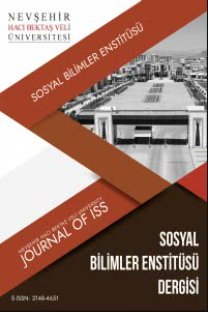TEKNOLOJİK GELİŞMENİN İSTİHDAM ÜZERİNDEKİ ETKİSİ: TÜRKİYE EKONOMİSİ ÜZERİNE SEKTÖREL BİR ANALİZ
Bir teknolojik gelişme göstergesi olan Arge harcamaları, yeni üretim süreçlerinin belirlenmesinde ve uygulanmasında önemli bir faktördür. Teknolojik gelişme, sektörler arasında yapısal değişikliklere neden olan bir olgudur. Üretim sürecinde üretim faktörlerinin ikame edilmesini etkileyen teknolojik ilerleme, ilgili sektörlerin istihdam yapısını da etkilemektedir. İşgücü talebi, yeni üretim teknolojilerine adaptasyon sürecinde endüstrilerin teknoloji yoğunluğuna göre değişiklik göstermektedir. Bu bağlamda, çalışmanın amacı 1996-2017 döneminde Arge harcamalarının sektörel istihdam üzerindeki etkilerini incelemektir. AMG yönteminden elde edilen bulgular, Arge harcamalarının tarım sektöründe istihdam oranını negtif yönde etkilediğini ortaya koymaktadır. Arge harcamalarındaki% 1'lik artış, tarım sektöründe istihdam oranını % 0,13 azaltmaktadır. Sanayi ve hizmetler sektöründe ise Arge harcamalarındaki % 1'lik artış, istihdamın payını sırasıyla% 0,16 ve % 0,26 artırmaktadır.
Anahtar Kelimeler:
sektörel istihdam, teknolojik gelişme, arge harcamaları
___
- Agovino, M., Aldieri, L., Garofalo, A., & Vinci, C. P. (2018). R&D Spillovers and Employment: Evidence from European Patent Data. Empirica, 45(2), 247-260.
- Bárány, Z. S. & Siegel, C. (2020). Biased Technological Change and Employment Reallocation. Labour Economics, 67, 101930.
- Bogliacino, F., Piva, M., & Vivarelli, M. (2014). Technology and Employment: The Job Creation Effect of Business R&D. Rivista Internazionale di Scienze Sociali, 3, 239-264.
- Bogliacino, F. & Vivarelli, M. (2014). The Job Creation Effect of R&D Expenditures. Australian Economic Papers, https://doi.org/10.1111/j.1467-8454.2012.00425.x
- Bond, S. & Eberhardt, M. (2013). Accounting for Unobserved Heterogeneity in Panel Time Series Models. Nuffield Collage, University of Oxford, Mimeo.
- Breusch, T. S. & Pagan, A. R. (1980). The Lagrange Multiplier Test and its Applications to Model Specification in Econometrics. The Review of Economic Studies, Econometrics Issue, 47(1), , 239-253.
- Brouwer, E., Kleinknecht, A. & Reijnen, J. O. (1993). Employment Growth and Innovation at the Firm Level. Journal of Evolutionary Economics, 3(2), 153-159.
- Cengiz, S. ve Şahin, A. (2020). Teknolojik İlerlemenin İstihdam Yaratmadaki Rolü ve Önemi: Türkiye Örneği. Karadeniz Uluslararası Bilimsel Dergi, 1(45), 160-172.
- Eberhardt, M. & Bond, S. (2009). Cross-section Dependence in Nonstationary Panel Models: A Novel Estimator. Munich Personal RePEc Archive Working Paper No. 17870, Germany.
- Eberhardt, M. & Teal, F. (2010). Productivity Analysis in Global Manufacturing Production. (Economic Series Working Paper 515). University of Oxford, Department of Economics.
- Evangelista, R. (2000) Innovation and Employment in Services, in M. Vivarelli and M. Pianta (eds). The Employment Impact of Innovation: Evidence and Policy, 121-48, London: Routledge,
- Evangelista, R. & M. Savona (2002) The Impact of Innovation on Employment in Services: Evidence from Italy. International Review of Applied Economics, 16, 309-18.
- Fung, M. K. (2006). Are Labor-Saving Technologies Lowering Employment in The Banking Industry? Journal of Banking & Finance,30,179-198.
- Greenan, N. & D. Guellec (2000). Technological Innovation and Employment Reallocation. Labour, 14, 547-90.
- Hollanders, H. & Weel, B. T. (2002). Technology, Knowledge Spillovers and Changes in Employment Structure: Evidence from Six OECD Countries. Labour Economics, 9(5), 579-599.
- Im, K. S., Pesaran, M. H. & Shin, Y. (2003). Testing for Unit Roots in Heterogeneous Panels. Journal of Econometrics, 115(1), 53-74.
- OECD (2012). Technology, Productivity And Job Creation: Best Policy Practices. http://www.oecd.org/industry/ind/2759012.pdf.
- Pesaran, M. H. (2004). General Diagnostic Tests for Cross Section Dependence in Panels. Cambridge Working Papers in Economics No. 0435, University of Cambridge.
- Pesaran, M. H. (2007). A Simple Panel Unit Root Test in the Presence of Cross‐section Dependence. Journal of Applied Econometrics, 22(2), 265-312.
- Piva, M. & Vivarelli, M. (2002). The Skill Bias: Comparative Evidence and an Econometric Test. International Review of Applied Economics, 16 (3), 347-357.
- Piva, M. & Vivarelli, M. (2017) Is R&D Good for Employment? Microeconometric Evidence from the EU. IZA Discussion Papers, No. 10581, Institute of Labor Economics (IZA), Bonn.
- Silva, H. G. & Lima, F. (2017). Technology, Employment and Skills: A Look into Job Duration. Research Policy, 46(8), 1519-1530
- Şahinoğlu, T. ve Varıcı, M. (2019). Teknolojik Gelişmenin İstihdam Üzerindeki Etkileri: Türkiye Örneği. Turkish Studies- Information Technologies and Applied Sciences, 14(4), 617-640-162.
- Tamayo, M. P. & Huergo, E. (2016). The Effect of R&D Services Offshoring on Skilled Employment: Firm Evidence. The World Economy, 39(9), 1414-1433.
- Taymaz, E (1996). Technological Change and Employment in Turkish Manufacturing Industries, in Bulutay, T. (ed.), Technology and Employment, p. 187-224, Ankara: SIS.
- Üçdoğruk, Y. (2006). Employment Impact of Product and Process Innovation in Turkey. Ege Akademik Bakış, 6(1), 87-99.
- Vivarelli, M. (2015). Innovation and Employment Technological Unemployment is not Inevitable- Some Innovation Creates Jobs, and Some Job Destruction can be Avoided. Innovation and Employment. IZA World of Labor, 154, https://www.nber.org/system/files/working_papers/w24196/w24196.pdf
- Yıldırım, T. (2020). The Causality Relationship Between R&D Expenditures and Unemployment in Turkey and Azerbaijan. TOGU Career Research Journal, 1(1), 10-15.
- Zhu, C., Qiu, Z. & Liu, F. (2021). Does Innovation Stimulate Employment? Evidence from China. Economic Modelling, 94, 1007-1017.
- Yayın Aralığı: Yılda 4 Sayı
- Başlangıç: 2011
- Yayıncı: Nevşehir Hacı Bektaş Veli Üniversitesi
Sayıdaki Diğer Makaleler
II. BEYAZIT TIP FAKÜLTESİNDE AKUSTİĞİN MİMARİ TASARIMA ETKİSİ
EFFIZIENZANALYSE FÜR LAPTOPS MIT DER INTEGRIERTEN ENTROPIE-EATWIOS-METHODE
HİNDİSTAN OTOMOBİL ENDÜSTRİSİNİN GELİŞİMİNDE DEVLETİN ROLÜ
Burcu YAVUZ TİFTİKÇİGİL, Ali Cem ÖZTÜRK
SİPARİŞ MALİYETİ YÖNTEMİ VE KAYSERİ MİMAR SİNAN ORGANİZE SANAYİ BÖLGESİ’NDE BİR UYGULAMA
ÖRGÜTSEL ÖZDEŞLEŞMENİN BİR ÖNCÜLÜ OLARAK ÖRGÜT KÜLTÜRÜ: HAVACILIK SEKTÖRÜNE YÖNELİK BİR ARAŞTIRMA
Funda YALIM, Kağan Cenk MIZRAK
KÜLTÜREL MİRAS TURİZMİ AÇISINDAN KRAL KIZI HAMAMI’NIN SWOT ANALİZİ İLE DEĞERLENDİRİLMESİ
ZİYARET FENOMENİ VE BİR TEDAVİ MERKEZİ OLARAK KAYSERİ ZİYARET YERLERİ
